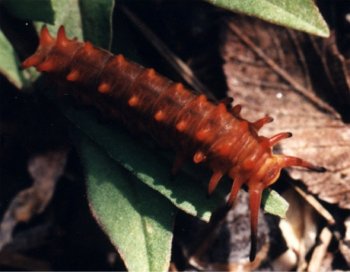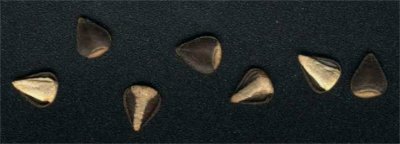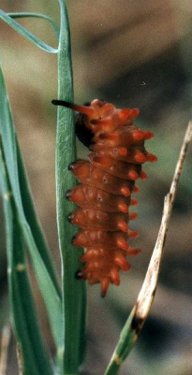Pipevines
by Valerie (July 26, 2000)
  I'll admit, I'm partial to non-traditional flowers, and the Dutchman's pipe, or, as I saw listed in a nursery catalog, the white-veined hardy Dutchman's pipe (Aristolochia fimbriata), is definitely one of my favorites. Although other types of pipevine are larger and showier, this little trailing species has such intricate blossoms, that it is worth getting down on the ground to get a close look. This pipevine happens to be fairly cold-hardy, simply dying back to the ground, while the large, tuberous root remains intact. It also weathers droughts well.
I'll admit, I'm partial to non-traditional flowers, and the Dutchman's pipe, or, as I saw listed in a nursery catalog, the white-veined hardy Dutchman's pipe (Aristolochia fimbriata), is definitely one of my favorites. Although other types of pipevine are larger and showier, this little trailing species has such intricate blossoms, that it is worth getting down on the ground to get a close look. This pipevine happens to be fairly cold-hardy, simply dying back to the ground, while the large, tuberous root remains intact. It also weathers droughts well.
 Originally from South America, Dutchman's pipe grows only about 6 inches high, has rounded, white-veined leaves, and very strange flowers, resembling the leaves of pitcherplants. Even the seeds and the pods are rather interesting. The flowers are pollinated by small flies that are attracted to their pungent odor (although I've never noticed any bad smell myself). However, the aroma must work, since most flowers are pollinated and produce little one-inch long pods resembling a horizontally ribbed watermelon. When this dries, it splits open between all the ribs, but the ribs remain intact, forming a little cage, with the seeds slipping out through the openings. The seeds are triangular, with an exposed hard white part embedded on one side of the larger dark segment. When the seed is wet, this dark part expands like a sponge and is thick and sort of slimy. The seeds are easy to germinate, and I've started new plants by just pressing them into the soil.  On a small plant like this, it is almost impossible to miss the large, fleshy caterpillars of the swallowtail. When they are small, the larvae are a bright orange color, but they darken as they get bigger, reaching a length of about two inches.
|


 A closely related plant that is a native here in central Texas is the swanflower (Aristolochia erecta). This plant also grows from a large root, which sustains it through drought and insect attacks. The pipevine caterpillars feed on this plant as well, and in fact, it is easier to find the insects than the plant itself, since it looks just like grass and grows in sunny, grassy areas. The first place I saw this flower was in McKinney Falls State Park, just east of Austin, on a well-trodden grassy slope. There were several flowers, some very indistinguishable plants, and lots of small orange caterpillars. I was immediately taken with the resemblance of the flowers to pitcherplant leaves. The seed pods and seeds are similar to Dutchman's pipe. Although I've tried to get the seeds to germinate, I've had no luck starting swanflowers so we don't have them in our gardens yet.
A closely related plant that is a native here in central Texas is the swanflower (Aristolochia erecta). This plant also grows from a large root, which sustains it through drought and insect attacks. The pipevine caterpillars feed on this plant as well, and in fact, it is easier to find the insects than the plant itself, since it looks just like grass and grows in sunny, grassy areas. The first place I saw this flower was in McKinney Falls State Park, just east of Austin, on a well-trodden grassy slope. There were several flowers, some very indistinguishable plants, and lots of small orange caterpillars. I was immediately taken with the resemblance of the flowers to pitcherplant leaves. The seed pods and seeds are similar to Dutchman's pipe. Although I've tried to get the seeds to germinate, I've had no luck starting swanflowers so we don't have them in our gardens yet.